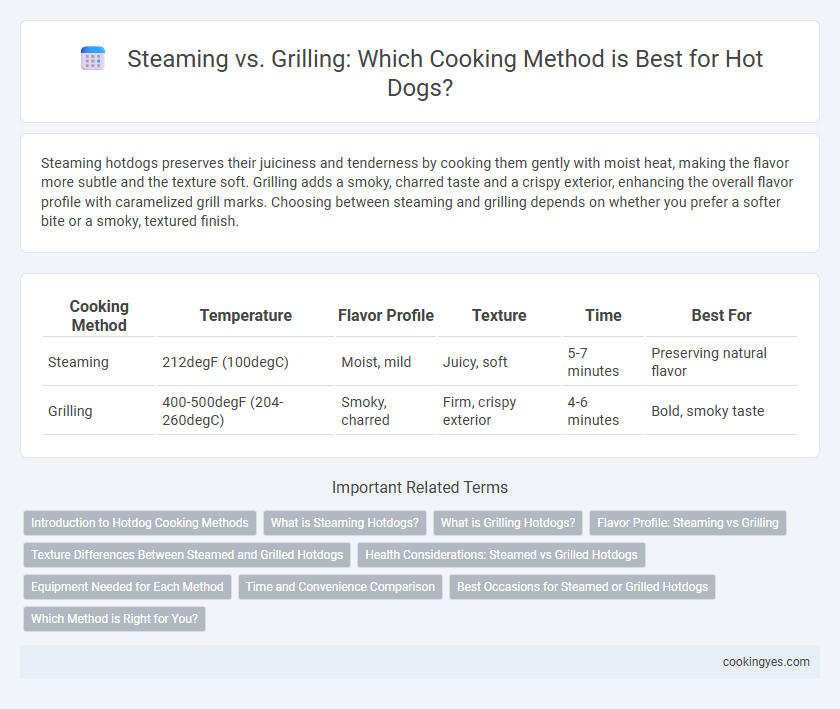Steaming hotdogs preserves their juiciness and tenderness by cooking them gently with moist heat, making the flavor more subtle and the texture soft. Grilling adds a smoky, charred taste and a crispy exterior, enhancing the overall flavor profile with caramelized grill marks. Choosing between steaming and grilling depends on whether you prefer a softer bite or a smoky, textured finish.
Table of Comparison
| Cooking Method | Temperature | Flavor Profile | Texture | Time | Best For |
|---|---|---|---|---|---|
| Steaming | 212degF (100degC) | Moist, mild | Juicy, soft | 5-7 minutes | Preserving natural flavor |
| Grilling | 400-500degF (204-260degC) | Smoky, charred | Firm, crispy exterior | 4-6 minutes | Bold, smoky taste |
Introduction to Hotdog Cooking Methods
Steaming hotdogs preserves moisture, resulting in a juicy texture that enhances the natural flavors, while grilling imparts a smoky, charred taste with appealing grill marks and a slightly crispy exterior. Steaming is ideal for retaining the hotdog's plumpness, using steam or boiling water, whereas grilling requires direct heat from a gas or charcoal grill, creating caramelization on the sausage skin. Choosing between steaming and grilling depends on desired texture and flavor profiles, with steaming favoring tenderness and grilling offering robust, smoky notes.
What is Steaming Hotdogs?
Steaming hotdogs involves cooking them with steam heat, which helps retain moisture and produces a juicy, tender texture without charring. This method uses a steam basket or a specialized steamer, ensuring even heat distribution while preserving the natural flavors of the hotdog. Steamed hotdogs are popular in many fast-food settings due to their consistent, succulent results.
What is Grilling Hotdogs?
Grilling hotdogs involves cooking the sausages directly over an open flame or hot grill surface, which imparts a smoky flavor and creates charred grill marks that enhance texture. This method uses high heat to sear the hotdog's exterior, locking in juices while caramelizing the natural sugars in the meat. Grilled hotdogs are popular for their crispy skin and savory, slightly smoky taste compared to steaming, which produces a softer, more evenly cooked hotdog.
Flavor Profile: Steaming vs Grilling
Steaming a hotdog preserves its natural juiciness and delivers a tender bite with subtle, mild flavors, highlighting the meat's original taste. Grilling imparts a smoky, charred flavor with a slightly crispy exterior, enhancing the savory profile and adding complex, caramelized notes. This contrast in cooking methods significantly affects the hotdog's overall flavor experience, catering to distinct taste preferences.
Texture Differences Between Steamed and Grilled Hotdogs
Steamed hotdogs have a soft and juicy texture due to the moist heat, which keeps the meat tender and plump. Grilled hotdogs develop a firmer bite with a slightly crispy and charred exterior, enhancing the smoky flavor and creating a contrast between the outside and the juicy interior. The choice between steaming and grilling directly impacts the overall mouthfeel, with steaming favoring moistness and grilling offering a textured, smoky experience.
Health Considerations: Steamed vs Grilled Hotdogs
Steaming hotdogs preserves moisture without adding harmful compounds, making it a healthier cooking method by avoiding the formation of carcinogenic substances like polycyclic aromatic hydrocarbons (PAHs) and heterocyclic amines (HCAs) that occur during grilling. Grilling at high temperatures can increase the presence of these potentially carcinogenic chemicals, which are linked to increased cancer risk. Choosing steaming reduces exposure to these harmful compounds while maintaining flavor and texture.
Equipment Needed for Each Method
Steaming hotdogs requires a steamer or a pot with a steaming basket to maintain consistent moisture and heat, ensuring evenly cooked and juicy results. Grilling hotdogs needs a grill or grill pan, which imparts a smoky flavor and creates char marks, enhancing the texture and taste. Both methods can be optimized with specific equipment like grill brushes or bamboo steamers to improve the cooking experience and final product quality.
Time and Convenience Comparison
Steaming hotdogs generally takes about 5-7 minutes and provides a quick, convenient method with minimal cleanup, making it ideal for indoor cooking. Grilling usually requires 10-15 minutes including preheating time but imparts a smoky flavor and crisp texture that steaming cannot achieve. For fast preparation and ease, steaming is preferable, while grilling suits those prioritizing taste and outdoor cooking experience.
Best Occasions for Steamed or Grilled Hotdogs
Steamed hotdogs are ideal for indoor gatherings and quick meals, preserving moisture and tenderness for a juicy bite. Grilled hotdogs excel at outdoor barbecues and cookouts, offering a smoky flavor and charred texture that enhances the eating experience. Choosing between steaming and grilling depends on the setting, with steaming suited for convenience and grilling perfect for social events.
Which Method is Right for You?
Steaming hotdogs preserves moisture and delivers a soft, juicy bite, making it ideal for those who prefer a tender texture. Grilling imparts a smoky flavor and crispy exterior, perfect for fans of a charred, robust taste. Choose steaming if you value juiciness and ease, or grilling if you seek bold flavor and a satisfying crunch.
Steaming vs Grilling for hotdog cooking Infographic

 cookingyes.com
cookingyes.com